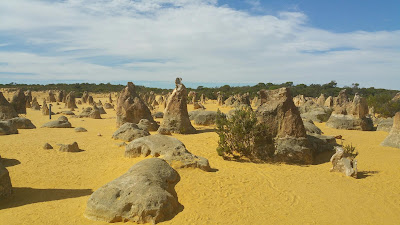Australia: The Pinnacles
On our attempt to explore the west coast Australia, we found ourselves driving more than 220km from Southern River WA all the way up to the Pinnacles Desert located in Nambung National Park for almost three hours.
Pinnacles Desert is world famous for its stromatolites and strombalites - the oldest living fossils on earth.
Ever wondered how this thousands of strange looking limestone pillars in different sizes were formed?
***
 The coast of Western Australia, from Shark Bay nearly to Albany, has a near continuous belt of Tamala Limestone (probably more accurately called) aerolian calcarenite - ie. wind blown calcium carbonate - which has been produced by the combination of wind, rain and the cementing agent of calcium.
The coast of Western Australia, from Shark Bay nearly to Albany, has a near continuous belt of Tamala Limestone (probably more accurately called) aerolian calcarenite - ie. wind blown calcium carbonate - which has been produced by the combination of wind, rain and the cementing agent of calcium.
Pinnacles Desert is world famous for its stromatolites and strombalites - the oldest living fossils on earth.
Ever wondered how this thousands of strange looking limestone pillars in different sizes were formed?
***
 The coast of Western Australia, from Shark Bay nearly to Albany, has a near continuous belt of Tamala Limestone (probably more accurately called) aerolian calcarenite - ie. wind blown calcium carbonate - which has been produced by the combination of wind, rain and the cementing agent of calcium.
The coast of Western Australia, from Shark Bay nearly to Albany, has a near continuous belt of Tamala Limestone (probably more accurately called) aerolian calcarenite - ie. wind blown calcium carbonate - which has been produced by the combination of wind, rain and the cementing agent of calcium.
A set of unique circumstances produced the pinnacles. Firstly the huge sand dunes stabilised. The rains which fell on the dunes leached down through the sand carrying the calcium. This resulted in the lower levels of the dune solidifying into a soft limestone. As this stabilisation occurred a layer of soil formed on top of the dune which allowed plants to grow and further cemented the limestone below. Gradually the lowest layer of soil, which lay between the surface and the limestone, formed into a hard cap which resulted in the old dunes having three levels - a soil and plant level near the surface, a hard cap below the surface, and a thick layer of soft limestone at the bottom of the dune.
Inevitably the roots from the plants on the top level found cracks and broke up the hard cap and the layer of soft limestone. The result was that under a surface covered with plants and soil the pinnacles developed. No one knows for sure how long ago this process occurred. It may have started as long ago as 500 000 years but equally it may only be a few thousand years old and it may still be continuing today. The Western Australian Museum has opted for some time in the last 80 000 years.
Inevitably the roots from the plants on the top level found cracks and broke up the hard cap and the layer of soft limestone. The result was that under a surface covered with plants and soil the pinnacles developed. No one knows for sure how long ago this process occurred. It may have started as long ago as 500 000 years but equally it may only be a few thousand years old and it may still be continuing today. The Western Australian Museum has opted for some time in the last 80 000 years.
Anyway the advent of drier weather in the region resulted in the top layer of plants and soil being removed and gradually the pinnacles were exposed so that today they stand like strange sentinels on a plain of wind blown sand.
*** Excerpts from www.visitpinnaclescountry.com.au
Amazing as the nature, these phenomenal rock formations formed over million of years ago is not only educational but also a perfect backdrop for crazy pictorials.








Comments